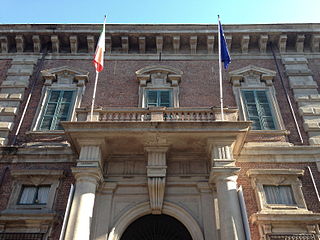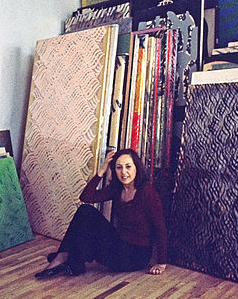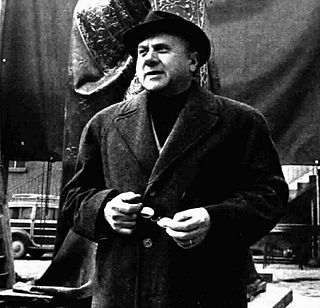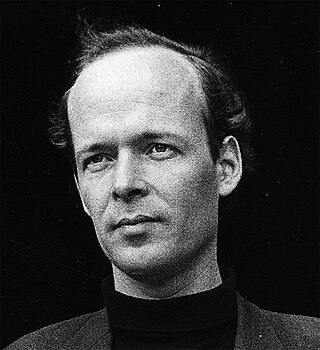Related Research Articles

Op art, short for optical art, is a style of visual art that uses optical illusions.

Bruno Munari was "one of the greatest actors of 20th-century art, design and graphics". He was an Italian artist, designer, and inventor who contributed fundamentals to many fields of visual arts in modernism, futurism, and concrete art, and in non-visual arts with his research on games, didactic method, movement, tactile learning, kinesthetic learning, and creativity. On the utility of art, Munari once said, "Art shall not be separated from life: things that are good to look at, and bad to be used, should not exist".

Giacomo Manzoni, known professionally as Giacomo Manzù, was an Italian sculptor.
Museums of modern art listed alphabetically by country.

The Accademia Carrara,, officially Accademia Carrara di Belle Arti di Bergamo, is an art gallery and an academy of fine arts in Bergamo, in Lombardy in northern Italy. The art gallery was established in about 1780 by Giacomo Carrara, a Bergamasco collector or conoscitore of the arts. The academy of fine arts was added to it in 1794. The school was recognised by the Ministero dell'Istruzione, dell'Università e della Ricerca, the Italian ministry of education, in 1988 and in 2023 merged with the Conservatorio Gaetano Donizetti to form the Politecnico delle Arti di Bergamo.

Palazzo Brera or Palazzo di Brera is a monumental palace in Milan, in Lombardy in northern Italy. It was a Jesuit college for two hundred years. It now houses several cultural institutions including the Accademia di Brera, the art academy of the city, and its gallery, the Pinacoteca di Brera; the Orto Botanico di Brera, a botanical garden; an observatory, the Osservatorio Astronomico di Brera; the Istituto Lombardo Accademia di Scienze e Lettere, a learned society; and an important library, the Biblioteca di Brera.

The Accademia di Belle Arti di Brera, also known as the Accademia di Brera or Brera Academy, is a state-run tertiary public academy of fine arts in Milan, Italy. It shares its history, and its main building, with the Pinacoteca di Brera, Milan's main public museum for art. In 2010 an agreement was signed to move the accademia to a former military barracks, the Caserma Magenta in via Mascheroni. In 2018 it was announced that Caserma Magenta was no longer a viable option, with the former railway yard in Via Farini now under consideration as a potential venue for the campus extension.

Günther Uecker is a German sculptor, op artist and installation artist.

Getulio Alviani was an Italian painter based in Milan. He is considered to be an important International Optical - kinetic artist.
Giuseppe Gabellone is an Italian artist who works in sculpture and photography. He lives and works in Paris.

Carla Accardi was an Italian abstract painter associated with the Arte Informel and Arte Povera movements, and a founding member of the Italian art groups Forma (1947) and Continuità (1961).

Francesco Messina was an Italian sculptor of the 20th century.

Gerhard von Graevenitz was a German kinetic artist, co-founding member of the Nouvelle Tendance and member of the op-art movement. He also belonged to the international circle of the Zero-Group. He is seen as one of the uncompromising representatives of the constructive-concrete art of the younger generation.
Ettore Sordini was an Italian artist, a disciple of Lucio Fontana, a friend and collaborator of Piero Manzoni and a member of the Gruppo del Cenobio.
Marina Apollonio is an Italian painter and optical artist. She lives and works in Padua.

Gregorio Vardanega was an artist of Italian origins who worked in Argentina and France. Vardanega and Martha Boto, his companion, created the term "chromocinetism" to describe their artistic research.
Gianni Colombo was an Italian artist, member of the kinetic art movement.

Martha Boto was an Argentine artist. Boto was born in Buenos Aires, Argentina, and was co-founder of the Group of Non-Figurative Artists of Argentina. She is considered to be a pioneer of kinetic and programmed art.

Giovanni Philippone was an Italian painter and sculptor.

Bruno Caruso was an influential Italian artist, graphic designer and writer who spent much of his adult life working in Rome.
References
- ↑ "Grazia Varisco". Archived from the original on 2020-02-22. Retrieved 2020-03-18.
- ↑ "Alla Triennale in mostra Grazia Varisco e l'opera si rivaluta". Il Sole 24 ORE. 18 October 2017.
- ↑ https://artfacts.net/movements/gruppo%20t [ dead link ]
- ↑ Grazia Varisco. Mit rastlosem Blick. Museum Ritter, 2013
- ↑ "L'oeil moteur. Art optique e cinétique / 1950–1975. Musée d'Art moderne et contemporain, 13 Mai / 25 Septembre 2005" (PDF). Archived from the original (PDF) on 2015-09-28. Retrieved 2015-09-28.
- ↑ "| Accademia di Brera | Sito ufficiale dell'Accademia delle Belle Arti di Brera Milano". www.accademiadibrera.milano.it. Retrieved Mar 19, 2019.
- ↑ "Grazia Varisco | Accademia di San Luca". www.accademiasanluca.eu. Retrieved Mar 19, 2019.
